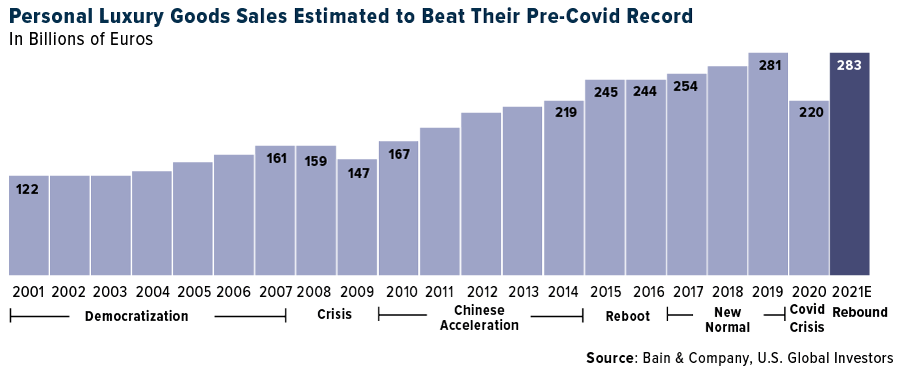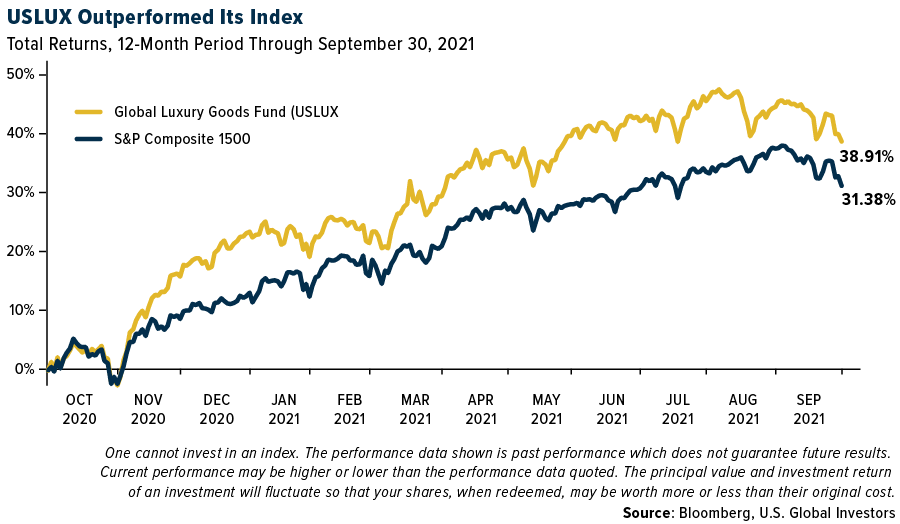by Frank Holmes, CEO, CIO, U.S. Global Investors
After plunging due to the global health crisis, the personal luxury goods market returned to pre-pandemic growth in 2021, with sales estimated to top 283 billion euros ($325 billion) by year-end, according to a new report by Bain & Company. That would represent a slight increase from then-record sales of 281 billion euros ($318 billion) in 2019.
Bain analysts note that these figures include only high-end merchandise, from leather handbags to jewelry to fragrances. Luxury “experiences,” such as travel and dining, still lag 2019 levels due to the ongoing pandemic.

Young Consumers in the U.S. and China Powering Growth
The V-shaped recovery was largely powered by the U.S. and China, with U.S. consumers outspending their Chinese counterparts by 1.5 times, the report says.
That’s despite the fact that the luxury market in China has nearly doubled since 2019. Consumers there are so hungry for luxury brands that Louis Vuitton is reportedly considering opening its first duty-free store in China, on the island-province of Hainan, which has rapidly become a luxury shopping destination for Chinese tourists unable to travel overseas due to pandemic restrictions.
Louis Vuitton, or LV, is the largest brand in the giant stable of luxury goods companies owned by LVMH Moët Hennessy Louis Vuitton. The Paris-based conglomerate reported record revenue of 44.2 billion euros ($51 billion) in the nine months ended September 30, an 11% increase from the same period in 2019.
Looking at demographics, the biggest contributors to the global sales recovery in 2021 were millennials and Gen Z, the oldest of whom are 40, according to Bain. These two cohorts are expected to make up 70% of all spending on luxury items by 2025.
Betting on Future Luxury Growth
Bain’s report helps underscore the reason why I was interested in providing an easy way for investors to gain access to the luxury goods market. As I’ve said before, there was initially some pushback to the idea, especially during the pandemic.
The Global Luxury Goods Fund (USLUX) became available in July 2020 after changing its name and investment strategy. Since then, it’s done better than even I imagined. For the 12-month period through September 30, USLUX beat its benchmark, the S&P Composite 1500, by more than 750 basis points, on impressive revenue generated by many of the fund’s top holdings.
That includes Tesla, which now ranks third among luxury automakers in the U.S., having surpassed Mercedes-Benz in sales during the first nine months of 2021. Toyota-owned Lexus holds the number two spot while BMW, also held in USLUX, tops the list. To see the top 10 holdings, click here.

Retail, and particularly luxury retail, has done very well during the pandemic as consumers reallocated discretionary spending from services to goods. Low interest rates and government-issued stimulus checks also supported consumption, which doesn’t appear to have been impacted by higher inflation.
Obviously these conditions won’t last forever, but I’m bullish on the luxury goods market, especially in China, India and other emerging markets that are seeing a steady expansion of household income as well as growth in the number of people joining their middle class.
Mutual fund investing involved risk. Principal loss is possible. Stock markets can be volatile and share prices can fluctuate in response to sector-related and other risks as described in the fund prospectus. Foreign and emerging market investing involves special risks such as currency fluctuation and less public disclosure, as well as economic and political risk. Companies in the consumer discretionary sector are subject to risks associated with fluctuations in the performance of domestic and international economies, interest rate changes, increased competition and consumer confidence.
The S&P Composite 1500 serves as a benchmark indicator for U.S. equity market performance, aggregating price movements of S&P 500, S&P MidCap 400 and S&P SmallCap 600. A basis point in one hundredth of a percent, equivalent to 1% of 1%.
Fund portfolios are actively managed, and holdings may change daily. Holdings are reported as of the most recent quarter-end. Holdings in the Global Luxury Goods Fund as a percentage of net assets as of 9/30/2021: LVMH Moet Hennessy Louis Vuitton 1.00%, Tesla Inc. 7.49%, Toyota Motor Corp. 0.00%, Bayerische Motoren Werke AG 2.91%.















